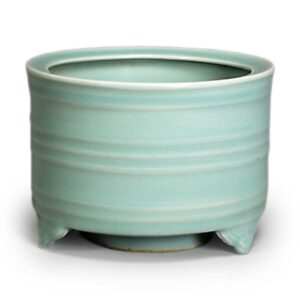
A vessel used for smelling incense by heaping fire on ashes. Various shapes are made from earthenware, copper, and other materials. They were originally made for the solemnity before the Buddha, and were first developed in copperware. The incense used for the solemnization of Buddhist rituals is called “kuko” (offering incense), while that for the reception of guests is called “kusei,” and the act of listening to and distinguishing incense is called “kikko” (listening to the fragrance) or “shikko” (distributing incense) after the incense ceremony began. The form of the censer, therefore, also differs from one to another. In “Kodo Senyo no Aki,” it is written, “A pair of incense burners is the prize, and they must be made of porcelain, not of painted wood or gold. In “Kotto Zassan” (A Discourse on Antiques), it is written, “The use of lions in many incense burners is based on a reference in a handbook of classics to the preference for gold emitters, and emitters are lions” and “Enbiikenki” says, “The height of a celadon incense burner is 2cm and its diameter is 2cm and 8 minutes, which is considered the best time to use it. The floating peony incense burner from Biwa-ji Temple (Ashikaga City, Tochigi Prefecture) and the Hakakoshi incense burner from Engakuji Temple (Kamakura City, Kanagawa Prefecture), both celadon incense burners and national treasures, are both said to have come from the Longquan kiln in China. There are several types of incense burners depending on their shape and usage, such as patterned incense burners, table incense burners, sleeve incense burners, tsuri incense burners, covered incense burners, and listening incense burners. Some of the most famous incense burners include Hotei, Fuji, Chidori, Shishi, Sanshoku Frog, Konoye, Tazhigyo, Shimei, and Asama. (Wameisho, Sannai Kucho, Wajihajime, Teijo Zakki, Manpozensho, Koshi, Gakkai Yojiru, Jibun Ruiju, Kakemono Zusetsu, Watanabe Koan Dialogue, Matsuya Wenki, Oda Nobunaga Fu, Sekijisha Zo, Kitaguni Mouzenki, Unpyo Zakki, Asama no Ki, Ruiju Meimonokou, Meimonokiki).



